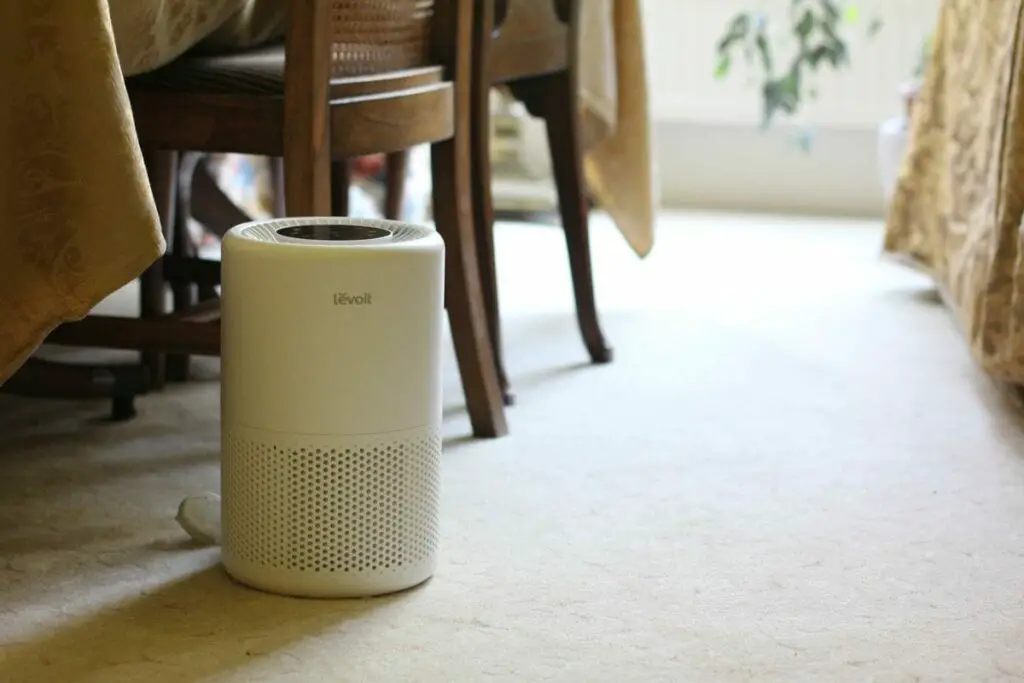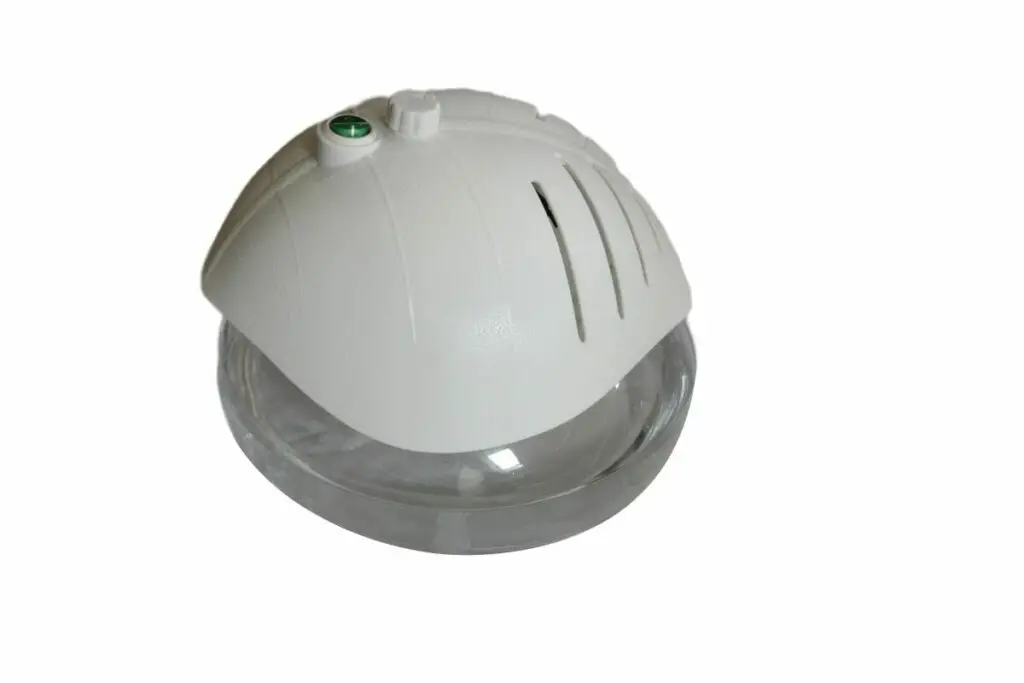Our indoor air is not always pleasant and clean both at home and work. Air purifiers work extremely well to clean the air removing both particles and chemicals very efficiently. It is also becoming clear that particles in the air damage human health, even within the range that we have considered normal. So it is not surprising that more and more people are thinking of buying an air purifier. But what to do for a smaller space? Should you really buy a small air purifier?
As a general rule you should not buy a very small air purifier as it is likely to be too noisy for you. The exception to this ie a desktop air purifier for work, which simply provides a personal space of purified air.
But at what stage as an air purifier become too noisy? And why does this happen? I outline the answers to both of these questions below this will help you decide where your own personal cutoff is and below which size you will not buy an air purifier.
What Criteria Do We Need For a Small Air Purifier
A small air purifier, like any air purifier, needs to have true HEPA filtration to remove particles and an activated carbon filter to remove chemicals. Other technologies have been tried to remove particles but they are not as effective as a true HEPA filter.
1) HEPA filtration
To provide excellent filtration of airborne particles, you should buy a HEPA air purifier, with a true HEPA filter, avoid those with “HEPA like” or “HEPA style”…. filters. HEPA filtration easily removes airborne particles with a very high efficiency. This efficiency is measured at 0.3um and to be certified as HEPA specification, the filter must remove 99.97% of the particles. However, this specification does not cover particles less than 0.1um, “ultrafine particles”.
Studies have also shown ultrafine particles can penetrate into the deepest areas of our lungs and then can enter our blood stream. So that when you breathe in ultrafine particles within 12-30 minutes, they appear in your bloodstream. These particles are found in normal indoor air, about 2 million particles per cubic liter, but at much higher concentrations during cooking. They have also been found in human brains and are thought to have serious health effects particularly provoking heart attacks. A few filters are also specified to deal with ultrafine particles. For additional information about ultrafine particles please see this article-“Airborne Ultrafine Particles-do they accelerate aging?”
A HEPA air filter will filter out (in order of descending size)-
- House dust mite
- Pet dander
- Pollen
- Mold Spores
- Airborne allergen
- Dust-household and atmospheric
- Bacteria
- Viruses
- Brake dust
- Tire dust
- Vehicle exhaust particles
- Smoke particles from both cigarette smoke and wildfire smoke
2) Activated Carbon filter
The air purifier should also have a carbon filter, as a HEPA filter cannot catch gaseous pollutants. This is because the molecules are too small to be trapped by the filter. The activated carbon removes airborne chemicals, these include volatile organic compounds, which cause odors. So this filter is sometimes referred to as the “odor filter” and can be especially helpful for reducing household odors such as pet odor.
For additional information, please see this article on how air purifiers work.
Of course, filter replacement will be necessary and the expense of this can be very different from one air purifier to another. Once the old filter is thrown out, the particles or chemicals stuck to it are removed from the home forever.
UV light is not essential in an air purifier and indeed, most of the top air purifiers do not have it. Its effectiveness is limited because the air passes by the UV light so quickly that there is little time for any micro-organism in the air to be irradiated and destroyed. So a HEPA filter is more effective at removing bacteria, mold spores and viruses. An air purifier should not produce ozone and one way of ensuring this is to buy a straight forward fan/carbon-filter/HEPA-filter air purifier.
Other air purifiers without HEPA filters are not recommended, as they have not been found to be as effective as HEPA filters.
3) Adequate Airflow
The EPA’s minimum standard for purifying air is that the air purifier should reduce the particle count in the air by 80% or more. This needs the air purifier to purify 4.9 times the volume of the room per hour. An air change is when a volume of air equal to the volume of the room has been purified, hence this standard is for 4.9 air changes per hour (ACH). So at a minimum, the volume of air in your room should go through the air purifier 4.9 times every hour. As the filter may not clean the air perfectly the concept of a clean air delivery rate (CADR) is used. This is defined as-
CADR=Filter Efficiency x Air Flow
As, filters are close to 100% efficient at removing particles, CADR should be very close to the airflow through the air purifier. Surprisingly an occasional quite well known manufacturer will refuse to give a CADR at all! You may wish to avoid these air purifiers, as you will not be able to size the air purifier for your room. You may also think that it implies there is something odd with the air purifier if the manufacturer will not give out this data.
Here is the EPA’s table of room size which indicates the minimum CADR that you need-

Do not judge an air purifier by its looks. Some of the best looking air purifiers have surprisingly low purified airflows. Neither is the robustness of construction a guide, there are robust air purifiers on the market that have very low airflows.
Also, please do not judge by how expensive an air purifier is. Some very expensive air purifiers have no clean air delivery rate (CADR) specified at all.
4) Tolerable Noise
An air purifier can have a great peak air flow, but you may not be able to tolerate the noise at that air flow, so you will switch it down to a tolerable noise level. If you sized the air purifier to your room at the maximum CADR this will mean that on the lower setting it will not purify your air adequately. So if you do not buy another air purifier you will be breathing in more particles with potentially adverse health effects. This can be avoided if you determine the maximum sound level that you are happy with and then find an air purifier that will produce a suitable CADR for your room size at or below this noise level. You can find further details about this here-“Buying an air Purifier“.
If you do not want to go through the process of finding the exact maximum level of sound that you can tolerate as outlined in the article on this website “Buying an Air Purifier” I would suggest aiming for a maximum noise level of 50db for a daytime room and 35db for a bedroom. If the air purifier manufacturer will not give you the CADRs at fan speeds where the noise output is at or below 50db (35db for a bedroom) then it is best not to buy that air purifier.
You could also simply follow the recommendations on this website which gives room sizes (assuming 8 foot ceilings) for air purifiers when they are producing less than 50db. The article on bedrooms “Best Air Purifier for a Bedroom” uses a maximum noise level of 35db.
Types of Small Air Purifiers
Small air purifiers can be broken down into 2 main types –
- desktop air purifiers-creating a personal space of purified air but not purifying the whole room. Matching the air flow, or really clean air delivery rate, to the room size is not an issue for these air purifiers because they are not trying to purify the air in the whole room.
- small room air purifiers-purifying whole room but only capable of handling small rooms
1) Desktop air purifiers
These are a relatively new concept in the best 2 models are the iQair Atem and the Dyson Pure Cool Me. Of these the IQ air Atem specifies particle filtration down to 0.003 micrometres and so is the most highly specified of the two. So it would logically be the choice for the best model on health grounds.

However the Dyson’s design is arguably more pleasing to the eye, and the air focusing mechanism is a superb piece of engineering. It may also be that the HEPA filter in the Dyson will remove ultrafine particles as small as the iQair atem, but it is not specified by the manufacturer to do so.
I have written an article about desktop air purifiers which you may find interesting, “Best desktop air purifier“.
2) Small Air Purifiers for Small Rooms
Obviously, small air purifiers cannot purify the air in larger rooms – they simply do not have the airflow capability. Having measured a few rooms, I am going to use 100 ft.² or less is the definition of a small room.
There is a noise problem with air purifiers in small rooms, the smaller the room, the closer you will be to the air purifier and so the noisier it will seem. In fact if you are sitting twice as close to an air purifier in the small room as he would in a large room, the noise from the air purifier will seem to be 4 times larger. This is because of the inverse square law with sound intensity falling off with the square of the distance a person is from the sound.
Also in the small room you have fewer options as to where to place the air purifier and so less chance of being further away from it. This will lead to a great magnification of the sound energy hitting your eardrums as outlined above.
In addition any reflection of sound from the walls of the room will also be traveling over shorter distances, and hence seem louder to your hearing.
All these factors will make an air purifier in the small room sound much louder, hence the need for the quietest possible air purifier in a small room.
This is especially so if your small room is a bedroom which is often the case.
In this context, smaller air purifiers have 2 problems –
1) they are relatively noisy for the amount of air that they process
Here is a table of air purifiers of different size together with the noise they produce. Please remember that every 10 dB increase in noise output sounds to the human ear like a doubling in noise intensity.
| Air Purifier | Air Purifier Size | Noise (db) |
|---|---|---|
| Coway 400S | Large | 21 |
| Winix AM 90 | Medium/Large | 32 |
| Levoirt 200S | Small | 40 |
| Germguardian 4100* | Very Small | 60 |
So in this example a large air purifier is half as noisy as a medium air purifier which is about half as noisy as a small air purifier. A very small air purifier is 4 times louder than a small air purifier and 16 times as loud as a large air purifier and even would only service a 75 sq ft room. So by having a large air purifier in the small room you can potentially have only a quarter of the noise of a small air purifier, this can be important because you will likely be sitting closer to the air purifier than you would be in a big room.
This it is hardly surprising that a small air purifier is noisier, as the same volume of air per minute flowing through a small tube (ie air purifier) will have to go much faster than it would flowing through a large tube (ie air purifier). The increased rate of flow will lead to a louder noise.
2) they also produce more high frequencies than larger air purifiers and these are more disturbing than low frequencies.
This is much like the effect of a violin versus a cello, the bigger the insturment the longer the wavelength of reverberating sound. The longer the wavelength the lower the frequency.
So ironically in a small room you may prefer a large air purifier which is ultra quiet and which emits lower frequency noise, as you are going to be so close to it.
This is especially so for a bedroom air purifier, the smaller bedrooms often being amongst the smallest rooms in the house.
The Best Small Air Purifier
Levoit 200S
This is an excellent cost effective option. Particle filtration is good However odor reduction is average. So if you have a problem with odor, for instance pet odor, you would be better choosing a larger air purifier with a large carbon filter. Please see “Best air purifier for Pets” for air purifiers with great odor removing capacity. Also as explained above noise is greater than for the 2 larger air purifiers but less than a mini air purifier.
This air purifier has the highest airflow per dollar of any air purifier on the market from a well known manufacturer, approximately double that of most other air purifiers.

Specifications
| Filters | |
| HEPA filter | HEPA 13 filter |
| Carbon filter amount of carbon | Small amount of carbon incorporated into main filter 0.1 lb |
| Filter Change HEPA (Particles) | 7 months |
| Filter Change Carbon (Chemicals) | 7 months |
| Airflow | |
| CADR at =<50db (CADR on Maximum) | 118 cfm (118 cfm) |
| Maximum Room Size (Noise less than 50db*) | 183 sq ft |
| Maximum Room Size (On noisiest setting) | 183 sq ft |
| Smart Control | Smart Phone App/Alexa/Google Home |
| Power | 37 W |
| Weight | 6.6 lb |
| Dimensions “H x “W x D” | 12.6 x 8.1 x 8.1inches |
| Annual Running Cost Electricity | $24 |
| Annual Running Cost Filters | $45 |
| Total Annual Running Cost | $70 |
Conclusion
If your indoor air quality is not as good as you wish or if you are simply persuaded of the health benefits of having indoor air with a low particle count then a small air purifier may be ideal in 2 situations-
1) An office where you have no control over air quality-a desktop air purifier providing purified air to your personal space. I would recommend the iQair Atem.
2) A small room over which you have control-a standard air purifier. Even here as explained above a larger rather than smaller air purifier is probably best. I would recommend the Coway 400S. However if cost is an issue and a cheap air purifier is needed, then the air cleaner with the most air purification per dollar is the Levoit 200S which is an excellent choice.
Related Questions
Related Articles
Water Air Purifier-3 Scientific tests may surprise you

Best Air Purifier for a Baby


